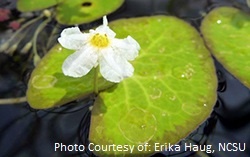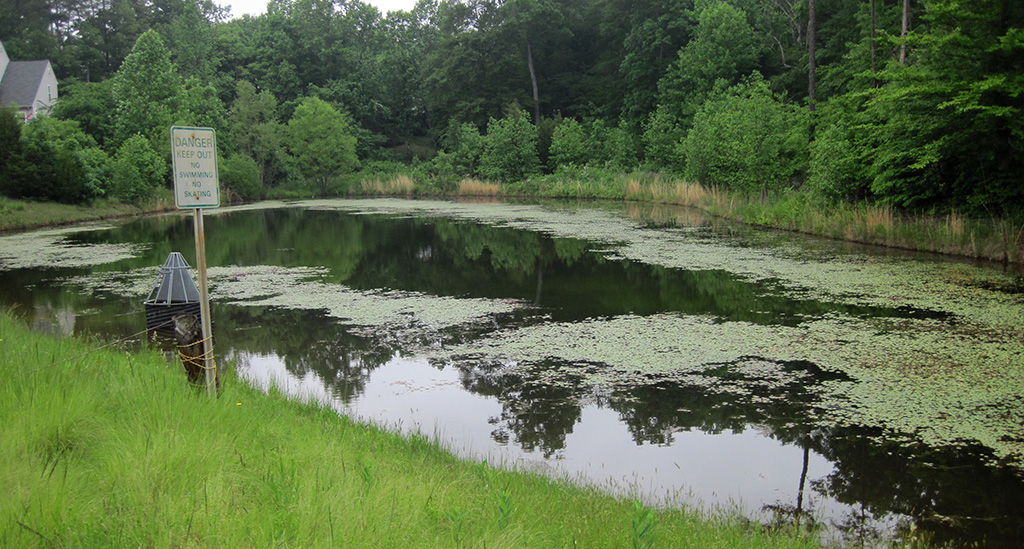
New Aquatic Invasive Species: Crested Floating Heart
By Industry Expert Shannon Junior, Aquatic Ecologist
 One of the challenges of working throughout the Mid-Atlantic region is becoming familiar with the variety of plants and wildlife that are native to the different climates and habitats, as well as the non-native, invasive plants that may be problematic in each area. When new invasive plants begin to invade a geographic area, it is often difficult to predict the tolerance of the plants to the climatic factors and the potential extent of the invasion.
One of the challenges of working throughout the Mid-Atlantic region is becoming familiar with the variety of plants and wildlife that are native to the different climates and habitats, as well as the non-native, invasive plants that may be problematic in each area. When new invasive plants begin to invade a geographic area, it is often difficult to predict the tolerance of the plants to the climatic factors and the potential extent of the invasion.
A new invasive species is making its way northward and could soon pose a significant problem for aquatic resources in the Mid-Atlantic States. Crested floating heart (Nymphoides cristata) is a rooted, floating-leaf plant that is native throughout Asia. Because it is an attractive plant with heart-shaped leaves and showy white flowers, it has been widely sold in the ornamental plant trade, which was the source of its introduction to the waters of the United States. It was initially identified in Naples, Florida in 1996, and began to spread rapidly through the canals of southern and central Florida. In 2006, it was found in Lake Marion in South Carolina, and in less than 2 years it spread from 20 acres to 2,000 acres!!
There is a related native plant called little floating heart (Nymphoides cordata) that can be found in most of the eastern United States. It looks similar to crested floating heart, but is not considered to be invasive. The leaves of the native floating heart are much smaller and darker in color, and the smaller white flowers lack the distinguishing crest on the petals that is characteristic of crested floating heart. Yellow floating heart (Nymphoides peltata) is another similar plant with yellow flowers that is distributed throughout most of the U.S. While it is also a non-native invasive, it is not spreading with nearly the same aggression as crested floating heart.

The reason that crested floating heart is so highly invasive is its unique reproductive habits. The primary strategy is through the production of daughter plants that develop on the stem, and eventually break free and float away to become rooted in another location. They can also potentially reproduce with bisexual flowers, although it is not yet known whether the seeds are viable. The scariest characteristic of the plant is its ability to reproduce by fragmentation. Recent research at North Carolina State University has found that plant fragments as small as half of a leaf can develop into mature, independent plants within a month. This response was observed in growth tanks with only tap water and no supporting nutrients, so one can only imagine how successful they would be in the nutrient-rich environments of our ponds and waterways. This fragmentation reproductive strategy is unusual among floating-leaf rooted species, and allows the plants to proliferate extremely rapidly.
Plants that reproduce by fragmentation can be particularly difficult to control since any kind of physical damage to the plants will accelerate their invasion. Fragmentation can occur naturally by insect grazing or storm events, but is more commonly caused by humans in areas where there is a lot of recreational use and boat traffic. Mechanical harvest, which is a commonly implemented Integrated Pest Management Strategy for nuisance aquatic vegetation control, is not effective on plants that reproduce by fragmentation because the practice would actually cause the plants to proliferate rather than control them.
So far, crested floating heart has only been found in the southernmost part of SOLitude’s service area in South Carolina. However, because the plants are known to be highly aggressive, it is important to keep an eye out for them and be aware that their distribution may be expanding. It is not known how much the spread and survival of crested floating heart will be limited by the colder temperatures in the northern climates, but we will be on the lookout throughout our service territories!
Information used in this blog post was sourced from: Erika Haug and Robert Richardson. “Modes of Reproduction in Crested Floating Heart (Nymphoides cristata).” Northeast Aquatic Plant Management Society. Gideon Putnam Resort and Spa, Saratoga Springs, NY. January 15, 2015.
Shannon Junior is an Aquatic Ecologist with SOLitude Lake Management. Since 1998, SOLitude Lake Management has been committed to providing full service lake and pond management services that improve water quality, preserve natural resources, and reduce our environmental footprint. Services are available throughout the Eastern United States. Fisheries management consulting and aquatic products are available nationwide. Learn more about SOLitude Lake Management and purchase products at www.solitudelakemanagement.com.









